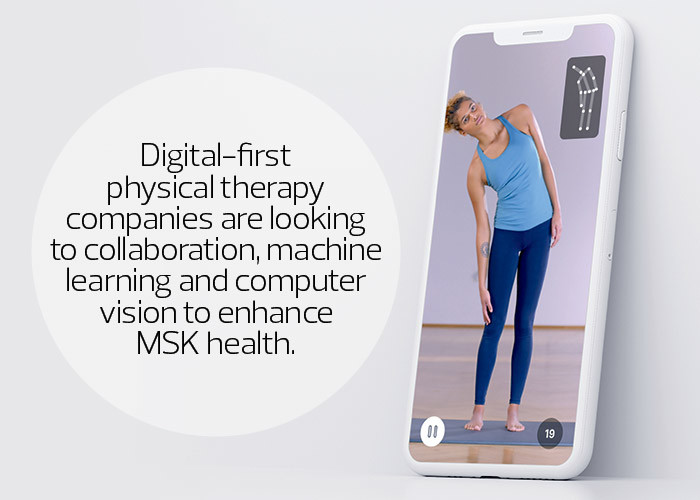Many digital physical therapy platforms experienced a jump in demand as the COVID-19 pandemic forced more people to work from home and limit travel, likely introducing or increasing musculoskeletal (MSK) issues.
But providing safe, accessible virtual physical therapy requires more than just a video call with a care provider. “Advanced digital technology can enable remote physical therapy that’s highly personalized and drives better patient engagement and outcomes,” says Dr. Jeff Krauss, chief medical officer at digital MSK clinic Hinge Health.
Here’s how some of the top virtual physical therapy companies are using innovation and industry collaboration to ensure accessibility and improved MSK health.
Click the banner below for access to exclusive HealthTech content and a customized experience.
The Physical Toll of Remote Work
According to Hinge Health's research, nearly half of the adults surveyed said they experienced increased back and joint pain since working from home, and 71 percent reported an increase in existing pain.
Hinge Health offers an end-to-end digital MSK clinic available to individuals and to employers to offer as a benefit for employees. The clinic features dedicated “playlists” of programs that address injury prevention, acute and chronic MSK conditions, and surgery rehabilitation with access to an integrated care team. Some programs give patients access to sensors for real-time feedback from providers and wearable technology for pain management.
RELATED: Learn how digital-first strategies are shaping healthcare.
“We are continuously innovating and building what’s next when it comes to the future of digital physical therapy, including applying machine learning and 3D computer vision technology to personalize MSK care,” Krauss says. “We are at the tip of the iceberg of what’s possible.”
Collaboration for Expansion of Physical Therapy
“Virtual physical therapy has tremendous opportunity to solve the current access and adherence challenges that limit the potential impact of physical therapy on MSK population health,” says Ryan Eder, founder and CEO of IncludeHealth. The company’s MSK-OS is a web-based operating system allowing providers to deliver personalized, measured care to patients 24/7 on any device.
IncludeHealth has partnered with nonprofit healthcare organization ProMedica, along with other health systems, national physical therapy networks and orthopedic clinics, to expand the reach of MSK-OS across healthcare services and settings.
Courtesy of Kaia Health
The virtual system can reach populations struggling to maintain physical therapy, Eder adds, including patients in rural areas without clinical access or working adults without daytime hours to spare.
“The future is a comprehensive hybrid care model that allows patients to receive the care they want and need at a time and place that is convenient for them, all delivered and tracked by their trusted providers,” Eder says.
A Hybrid Approach to Physical Therapy
Helping patients with their care ecosystem is critical as interest in virtual physical therapy grows, says Kim Clarno, director of clinical experience at Kaia Health, which offers a digital platform that delivers holistic strategies for MSK conditions, the full body and behavioral health.
“The future holds great promise for integrating telephysical therapy that is augmented by automated digital therapy into the full MSK experience,” Clarno says.
LEARN MORE: How are healthcare organizations implementing digital strategies at a faster rate?
Kaia Health announced a unique online-offline partnership with Luna On-Demand Physical Therapy that will expand access to care for more members, including high-risk patients.
Bidirectional data sharing, coach-clinician collaboration, cross-functional referrals and tandem app/traditional therapy are key components of this effort, Clarno says.
“This will bring the best physical therapy to all patients regardless of their ability to travel to a specialty clinic or lack of a broadband connection adequate enough for telephysical therapy consultations, thus transforming access to care and improving outcomes through a fully integrated care pathway,” she says.












